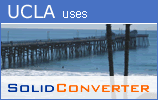With so many different graphic file formats, how do you know which one to choose for your project? Each file format has advantages and drawbacks that make it better suited to one file type or another. Use the chart below to decide which file type is best for you.
|
File Extension |
Advantages |
Disadvantages |
Best for... |
| BMP | File quality can be maintained when file is resized.
Loads quickly since it is not compressed. | Cannot be used on the Web.
Large file size. | Print graphics such as logos or icons. |
| TIF | Can be very high resolution.
Can be used by most scanning and graphics programs. | Large file size. | Scanned images and photographs. |
| GIF | Small file size.
Can be used on any browser.
Can have animated, transparent, or regular GIFs.
Lossless compression - image doesn't degrade when file size is reduced. | Can contain only 256 colors or fewer.
8-bit only. | Line drawings; pictures and drawings with large areas of solid color. |
| JPG | Contains millions of colors (24-bit palette). | Lossy compression - when files are reduced in size, image is degraded.
May take longer to load because of decompression time. | Photographic images.
Images with subtle color gradations. |
| PNG | Can be 8-bit, 24-bit, or 32-bit.
Lossless compression.
Endorsed by the World Wide Web consortium (W3C).
Can store alpha channel (variable) transparency.
Supports gamma correction (cross-platform control of image brightness.
Supports two-dimensional interlacing (a method of progressive display). | Does not yet have complete alpha channel support in IE. Not supported by some (pre-2001) older browsers. | Any type of Web graphic except animations. |
